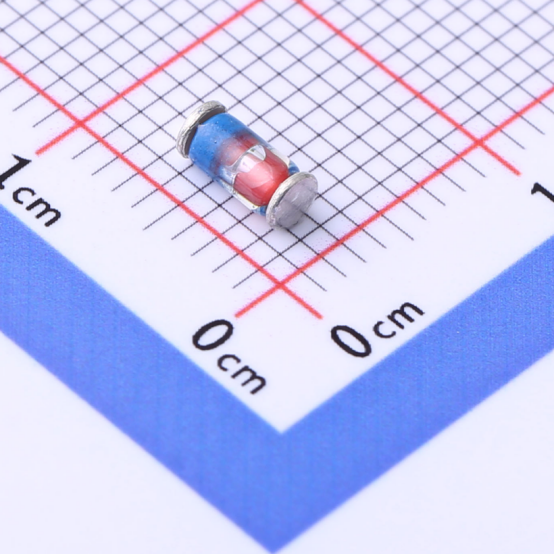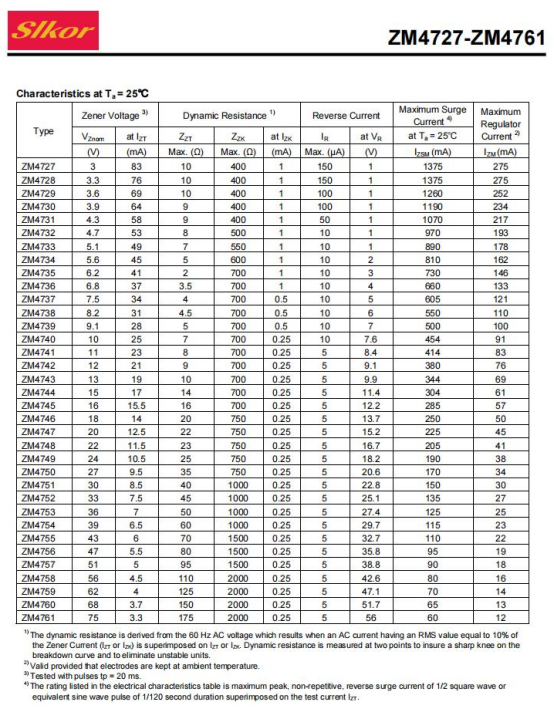Service hotline
+86 0755-83044319
release time:2024-06-03Author source:SlkorBrowse:10919
Features of the voltage regulator diode ZM4749A
The ZM4749A is a voltage regulator diode with a stabilizing value of 24V. This means that when the diode operates normally in a circuit, it will maintain the voltage across its terminals within approximately a 24V range. This characteristic makes the ZM4749A very useful in applications requiring precise voltage output.

Slkor Voltage Regulator Diode ZM4749A product photo
Regarding accuracy, the ZM4749A has a voltage regulation accuracy of ±5%. This means that under normal operating conditions, its actual stabilizing value may fluctuate between 22.8V and 25.2V. Although this fluctuation range is relatively small, it still needs to be considered in applications with extremely high voltage accuracy requirements.
In terms of power, the ZM4749A has a rated power of 1W. This means that it can operate stably for a long time without exceeding 1W of power. When the current or voltage in the circuit exceeds this range, the diode may be damaged or fail. Therefore, when designing the circuit, it is necessary to ensure that the operating conditions of the ZM4749A do not exceed its rated power.

Slkor Voltage Regulator Diode ZM4749A specification
Reverse current (Ir) is an important parameter of voltage regulator diodes. For the ZM4749A, its reverse current is 5μA at 18.2V. This parameter describes the magnitude of the current passing through the diode when it is reverse biased. In practical applications, the magnitude of reverse current usually does not have a significant impact on the circuit, but it may need to be considered in certain specific applications.
Impedance (Zzt) is another key parameter of voltage regulator diodes. For the ZM4749A, its impedance is 25Ω. This parameter describes the equivalent resistance across the terminals of the diode when it is in the voltage regulation state. The magnitude of impedance will affect the distribution of current and voltage in the circuit, so it needs to be fully considered when designing the circuit.

Parameters of Slkor Voltage Regulator Diode ZM4749A
Identification and Judgment of Voltage Regulator Diodes
Appearance Identification
Firstly, visually identify the voltage regulator diode by its appearance. Voltage regulator diodes usually have a similar appearance to regular diodes, but there are specific markings or color codes on the body to indicate their voltage regulation value. These markings may be a combination of numbers, letters, or colors, depending on the manufacturer and model.
Model Identification
The model is crucial for identifying voltage regulator diodes. For example, a model like ZM4749A typically includes key parameters such as the voltage regulation value (in this example, 24V), accuracy, power, and so on. Detailed information about a specific model can be obtained by referring to the datasheet provided by the manufacturer or online resources.
Electrical Parameter Judgment
● Voltage Regulation Value Judgment: To determine the actual voltage regulation value of the voltage regulator diode, a voltmeter can be used to measure the voltage across its terminals in the circuit. Connect the voltage regulator diode to an appropriate resistor and power supply, adjust the power supply voltage, and observe the voltmeter reading. When the voltmeter reading stabilizes near the expected voltage regulation value, the voltage regulation value of the diode can be confirmed.
● Accuracy Judgment: Accuracy is an important parameter of voltage regulator diodes, indicating the range of fluctuation of their voltage regulation value. To judge the accuracy of a voltage regulator diode, repeat the voltage regulation value measurement process mentioned above and record the results of multiple measurements. If the fluctuation range of the measurement results falls within the manufacturer's specified accuracy range, the accuracy of the voltage regulator diode is considered to meet the requirements.
● Reverse Current Judgment: Reverse current is the current that flows through the voltage regulator diode when it is reverse biased. To measure the reverse current, connect the voltage regulator diode in reverse to the power supply and ammeter. Gradually increase the power supply voltage while observing the ammeter reading. When the voltage reaches a specific value (such as 18.2V for ZM4749A), record the ammeter reading, which represents the magnitude of the reverse current. If the reverse current is too high, it may indicate that the voltage regulator diode is damaged or performing poorly.
● Impedance Judgment: Impedance is the equivalent resistance of a voltage regulator diode in a regulated state. To measure the impedance, connect the voltage regulator diode to an appropriate resistor and power supply, and use a voltmeter and ammeter to measure the voltage across its terminals and the current passing through it. Calculate the impedance value using Ohm's law (V=IR). If the measured result is close to the impedance value provided in the manufacturer's datasheet, the impedance of the voltage regulator diode is considered to meet the requirements.
Functional Judgment In addition to the above electrical parameter judgments, the operational status of the voltage regulator diode can also be judged by observing its function in the circuit. For example, in a power supply circuit, the voltage regulator diode is used to stabilize the output voltage. If the output voltage in the circuit remains stable and matches the expected value, it indicates that the voltage regulator diode is functioning properly. If the output voltage fluctuates significantly or does not match the expected value, it may be necessary to check whether the voltage regulator diode is damaged or performing poorly.
About Slkor:
Slkor has research and development offices in Busan, South Korea, Beijing, China, and Suzhou, China. Most of the wafer manufacturing and packaging and testing are carried out within China. The company employs and collaborates with individuals and organizations worldwide, with a laboratory for product performance and reliability testing and a central warehouse located at its headquarters in Shenzhen. Slkor has filed for over a hundred invention patents, offers more than 2,000 product models, and serves over ten thousand customers globally. Its products are exported to countries and regions including Europe, the Americas, Southeast Asia, and the Middle East, making it one of the rapidly growing semiconductor companies in recent years. With well-established management systems and streamlined workflows, Slkor has rapidly enhanced the brand awareness and reputation of its "SLKOR" brand through its outstanding quality and standardized services. Its product range includes three major series: diodes, transistors, and power devices, with recent introductions of new products such as Hall elements and analog devices, expanding its presence in sensors, Risc-v microcontrollers, and other product categories.









Site Map | 萨科微 | 金航标 | Slkor | Kinghelm
RU | FR | DE | IT | ES | PT | JA | KO | AR | TR | TH | MS | VI | MG | FA | ZH-TW | HR | BG | SD| GD | SN | SM | PS | LB | KY | KU | HAW | CO | AM | UZ | TG | SU | ST | ML | KK | NY | ZU | YO | TE | TA | SO| PA| NE | MN | MI | LA | LO | KM | KN
| JW | IG | HMN | HA | EO | CEB | BS | BN | UR | HT | KA | EU | AZ | HY | YI |MK | IS | BE | CY | GA | SW | SV | AF | FA | TR | TH | MT | HU | GL | ET | NL | DA | CS | FI | EL | HI | NO | PL | RO | CA | TL | IW | LV | ID | LT | SR | SQ | SL | UK
Copyright ©2015-2025 Shenzhen Slkor Micro Semicon Co., Ltd